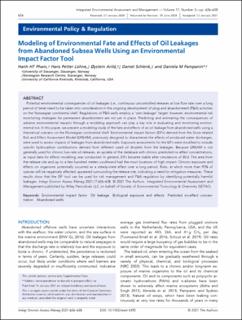| dc.contributor.author | Pham, Hanh HT | |
| dc.contributor.author | Lohne, Hans Petter | |
| dc.contributor.author | Arild, Øystein | |
| dc.contributor.author | Schlenk, Daniel | |
| dc.contributor.author | Pampanin, Daniela M | |
| dc.date.accessioned | 2021-08-25T08:44:48Z | |
| dc.date.available | 2021-08-25T08:44:48Z | |
| dc.date.created | 2021-07-12T15:48:14Z | |
| dc.date.issued | 2021 | |
| dc.identifier.citation | Integrated Environmental Assessment and Management. 2021, 17 (3), 1-13. | en_US |
| dc.identifier.issn | 1551-3777 | |
| dc.identifier.uri | https://hdl.handle.net/11250/2771109 | |
| dc.description.abstract | Potential environmental consequences of oil leakages (i.e., continuous uncontrolled releases at low flow rate over a long period of time) need to be taken into consideration in the ongoing development of plug and abandonment (P&A) activities on the Norwegian continental shelf. Regulations of P&A wells employ a “zero leakage” target; however, environmental risk monitoring strategies for permanent abandonment are not yet in place. Predicting and estimating the consequences of adverse environmental impacts through a modeling approach can play a key role in evaluating and monitoring environmental risk. In this paper, we present a modeling study of the fate and effects of an oil leakage from abandoned wells using a theoretical scenario on the Norwegian continental shelf. Environmental impact factors (EIFs) derived from the Dose related Risk and Effect Assessment Model (DREAM), previously designed to characterize the effects of produced water discharges, were used to assess impacts of leakages from abandoned wells. Exposure assessments for the EIFs were modified to include specific hydrocarbon contributions derived from different sized oil droplets from the leakages. Because DREAM is not generally used for chronic low-rate oil releases, an update of the database with chronic predicted no-effect concentrations, as input data for effects modeling, was conducted. In general, EIFs became stable after simulations of 30 d. The area from the release site and up to a few hundred meters southward had the most locations of high impact. Chronic exposure and effects on organisms potentially occurred as a steady-state effect over a long period. Risks, at which more than 95% of species will be negatively affected, appeared surrounding the release site, indicating a need for mitigation measures. These results show that the EIF tool can be used for risk management and P&A regulation by identifying potentially harmful leakages. | en_US |
| dc.language.iso | eng | en_US |
| dc.rights | Navngivelse 4.0 Internasjonal | * |
| dc.rights.uri | http://creativecommons.org/licenses/by/4.0/deed.no | * |
| dc.title | Modeling of Environmental Fate and Effects of Oil Leakages from Abandoned Subsea Wells Using an Environmental Impact Factor Tool | en_US |
| dc.type | Peer reviewed | en_US |
| dc.type | Journal article | en_US |
| dc.rights.holder | © 2021, Author(s) | |
| dc.description.version | publishedVersion | en_US |
| cristin.ispublished | true | |
| cristin.fulltext | original | |
| cristin.qualitycode | 1 | |
| dc.identifier.doi | 10.1002/ieam.4392 | |
| dc.identifier.cristin | 1921527 | |
| dc.source.journal | Integrated Environmental Assessment and Management | en_US |
| dc.source.volume | 17 | en_US |
| dc.source.issue | 3 | en_US |
| dc.source.pagenumber | 1-13 | en_US |

